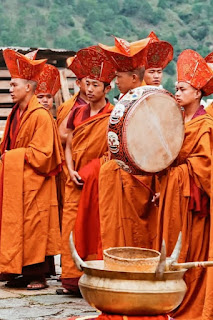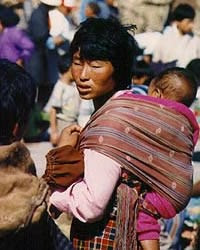Mythologies of the Ngalop Tribe
The Ngalop (Dzongkha: སྔ་ལོང་པ་ Wylie: snga long pa; "earliest risen people" or "first converted people" according to folk etymology) are people of Tibetan origin who migrated to Bhutan as early as the ninth century. Orientalists adopted the term "Bhote" or Bhotiya, meaning "people of Bod (Tibet)", a term also applied to the Tibetan people, leading to confusion, and now is rarely used in reference to the Ngalop. The Ngalop introduced Tibetan culture and Buddhism to Bhutan and comprise the dominant political and cultural element in modern Bhutan. Furthermore, cultural, ethnic, and linguistic identity in Bhutan are not always mutually exclusive. For these reasons, Ngalops are often simply identified as Bhutanese. Their language, Dzongkha, is the national language and is descended from Old Tibetan. The Ngalop are dominant in western and northern Bhutan, including Thimphu and the Dzongkha-speaking region. The term Ngalop may subsume several related linguistic and cultural groups, such as the Kheng people and speakers of Bumthang language.
Buddhism is the most widely practiced religion in Bhutan — an estimated two-thirds to three-quarters of the population are adherents — so the Ngalop people hold a special place in their country. “Ngalop means ‘the first risen,’ and they are known as the people who brought Tibetan Buddhism to Bhutan when they migrated there in the ninth century,” says Nelson. The Ngalop live mainly in the northwest region of the country. Symbolizing different deities, demons and animals, the masks are used when the Ngalop act out spiritual stories from their collective past. In this photo, they’re dressed for the annual Tshechu festival. “Religious gatherings such as the Tschechu festival are an important way to promote and share cultural heritage between the people from remote villages,” Nelson says. The temple complex seen on the left-hand side of the image is Paro Taktsang or “The Tiger’s Nest.” Located more than 10,000 feet above sea level, it is is one of the most sacred sites in Bhutan.
The Ngalop ethnic group of Bhutan, settling in the west of the country, are people of Tibetan who migrated to Bhutan in the ninth century. For this reason, they are referred to by the name Bhote which means the people of Tibet. In the past, Ngalop was the pioneer who introduced Buddhism and Tibetan culture to the kingdom. So far, the Ngalop culture and linguistics have created significant influences in modern Bhutan and thus they are often recognized as the Bhutanese people. Here is some worthy information that gives you a glimpse of the ethnic group of the country. Nowadays, the Ngalop mainly populates the West and the North of Bhutan. According to the demographic statistic in 1981, the Ngalop took up about 17% of the Bhutan population. The main language of the Ngalops is Dzongkha (meaning the language of the district) which was spoken by approximately half of the Bhutanese people around the country. As the dominance of the Ngalop throughout the country, Dzongkha has become the national language of Bhutan since 1971. Most Nalops practice Tibetan Buddhism with the Drukpa Lineage of Vajrayana form that appreciates the important role of the Avalokitesvara Bodhisattva in the spiritual life of people. Faith plays a significant part in Ngalop’s culture, customs, and way of life. Through the ups and downs of the historical journey of the outside world, the Ngalops still maintain their un-spoilt Buddhism as a mental treasure of the Thunder Dragon Kingdom in the Himalayas. Buddhism encourages people to live in harmony with nature and pay reverence to the motherland where they were born. This can be reflected in some of the certain rules when visiting Bhutan that visitors are hoped to follow. For instance, tourists are proposed not to pick up any stones and throw them into the lake because it is considered a disrespect to the sacred land.
The Ngalop or Ngalong have their origins in Tibet and migrated to Bhutan in the 800 's. They are at the forefront in politics and culture in Bhutan particularly in the capital Thimpu and northern and western Bhutan. The Ngalog speak Dzongkha which is the main Bhutanese language and is spoken by the government and in schools. The Ngalog eat red rice, potatoes and barley. Their houses are built of timber, stone, bricks and clay. Most of the government and the monarchy are Ngalog. The Ngalog have built monasteries that are used as government offices. Tibetan Buddhism is their main religion. A smaller number of them follow the Bon religion which is based on shamanism.
The Ngalops, also known as “earliest risen people” are people who may have originated in from the Tibet region and moved into Bhutan around the 9th century. Thus, they are always referred to as “Bhote” people in most literature, meaning “people of Bhotia or Tibet.” The term, which also applies to the Tibetan people, is now rarely used in reference to the Ngalop people to avoid the confusion. The Ngalop together with the Sharchops comprises about 63% of the population of Bhutan or 450,000 people.
The Ngalop (Dzongkha: སྔལོངཔ་ Wylie: snga long pa; "earliest risen people" or "first converted people" according to folk etymology)[1] are people of Tibetan origin who migrated to Bhutan as early as the ninth century. Orientalists adopted the term "Bhote" or Bhotiya, meaning "people of Bod (Tibet)", a term also applied to the Tibetan people, leading to confusion, and now is rarely used in reference to the Ngalop. The Ngalop introduced Tibetan culture and Buddhism to Bhutan and comprise the dominant political and cultural element in modern Bhutan. Furthermore, cultural, ethnic, and linguistic identity in Bhutan are not always mutually exclusive. For these reasons, Ngalops are often simply identified as Bhutanese. Their language, Dzongkha, is the national language and is descended from Old Tibetan. The Ngalop are dominant in western and northern Bhutan, including Thimphu and the Dzongkha-speaking region. The term Ngalop may subsume several related linguistic and cultural groups, such as the Kheng people and speakers of Bumthang language.
The Ngalop (a term thought to mean the earliest risen or first converted) are people of Tibetan origin who migrated to Bhutan as early as the ninth century. For this reason, they are often referred to in foreign literature as Bhote (people of Bhotia or Tibet). The Ngalop are concentrated in western and northern districts. They introduced Tibetan culture and Buddhism to Bhutan and comprised the dominant political and cultural element in modern Bhutan. The Ngalop call themselves Drukpas (dragon people). They are ethnically related to the Tibetans and practice a form of Buddhism closely related to the Lamaism (Tibetan Buddhism) of Tibet. Many Bhutanese have traditionally lived in and around monasteries. Dzongka, the official language of Bhutan, and the language of the Ngalop, is also basically Tibetan. Drukpas can also be a collective term that describes the Ngalops, Sharchops and the indigenous tribal people. The Ngalops (also known as Bhote, Bhotia, Bhutia) live in mainly western and central Bhutan but also make up a large percentage of the mountainous, sparsely-populated north. They migrated from the Tibetan plateau and are credited with being the first to bring Buddhism to the country. They are closely related to Tibeto-Nepalese (Bhote people) in Nepal as well as Sikkimese and Ladakhis in India and Tibetan groups in Tibetan and China.











































Comments
Post a Comment